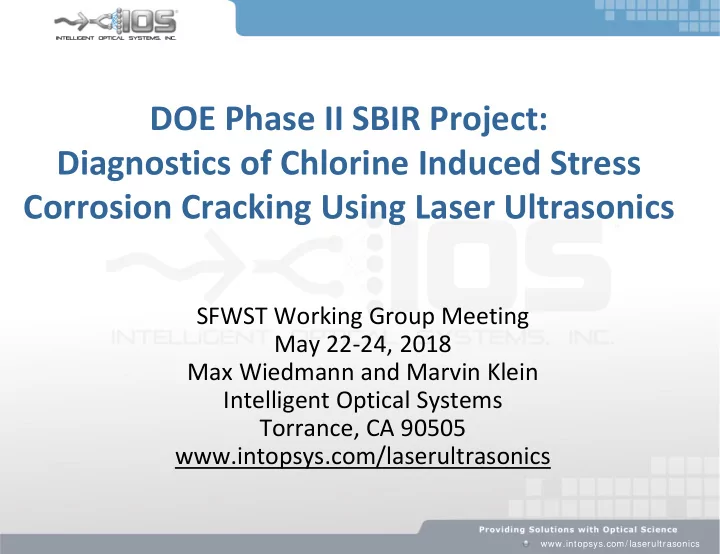

DOE Phase II SBIR Project: Diagnostics of Chlorine Induced Stress Corrosion Cracking Using Laser Ultrasonics SFWST Working Group Meeting May 22-24, 2018 Max Wiedmann and Marvin Klein Intelligent Optical Systems Torrance, CA 90505 www.intopsys.com/laserultrasonics www.intopsys.com/ laserultrasonics
Outline Laser ultrasonic testing − Introduction − Benefits Project goals and description Project team Project progress and results www.intopsys.com/ laserultrasonics
Laser Ultrasonic Testing (LUT): System Layout Remote base station with fiber delivered measurement head Base Station Fiber Umbilical Pulsed Generation Laser Measurement Head Fiber Coupler CW Probe Laser Sample with Crack I Receiver O www.intopsys.com/ laserultrasonics
Benefits of Laser Ultrasonic Testing (LUT) Noncontact: Lasers generate and detect ultrasound Operates on rough, curved, corroded surfaces Small laser spots enable isolation of individual cracks High bandwidth for accurate depth measurement Small, fiber-delivered measurement head enables access to confined spaces Purely optical inspection probe, no electronics www.intopsys.com/ laserultrasonics
Broad Goals of DOE SBIR Technical: demonstrate that LUT can measure the depth profile (depth vs. position) of a stress corrosion crack with acceptable accuracy Integration: demonstrate a practical means for delivering and scanning the beams inside a DCSS, in the presence of radiation and heat www.intopsys.com/ laserultrasonics
DOE SBIR Phase II Team Intelligent Optical Systems : project lead; laser ultrasonic technology RTT : robotic integration EPRI : access to mockup and eddy current system for demonstration Diakont, Structural Integrity : NDE guidance Randy Granaas – Southern California Edison (SONGS) and Matt Keene – Duke Energy: industry guidance Prasad Nair – DOE NV: Technical Monitor www.intopsys.com/ laserultrasonics
Basic B-Scan Pattern Scan along full length of crack Detection Generation Crack Experiments performed on EDM notches and real SCC cracks www.intopsys.com/ laserultrasonics
Beam Configuration: Time of Flight Diffraction Technical objective: detect diffracted longitudinal (L) wave Time delay gives notch or crack depth Scanning into page Generation beam Detection beam Rayleigh wave Generated ultrasonic pulse Skimming L wave from surface ablation Diffracted L wave (LL) Incident L wave EDM notch or crack Sample www.intopsys.com/ laserultrasonics
EPRI EDM Notch Samples Curved Shape; Each With Four Notches Sample 6 13.0 mm thick Sample 7 16.6 mm thick Sample 8 16.6. mm thick www.intopsys.com/ laserultrasonics
Sample 6, Flaw 1 Rayleigh wave Flaw properties • Apparent notch depth profile is Extent of crack flat, not curved as drawn above • Notch is very tight, as indicated by remnant skimming wave Time signal over notch delay • Measured crack depth of 6.1 mm agrees with stated depth of 6.55 mm. Skimming wave Notch-diffracted LL wave www.intopsys.com/ laserultrasonics
Fatigue Crack Sample From Trueflaw (Finland): Crack Specifications Destructive testing: 6.4 mm www.intopsys.com/ laserultrasonics
Photo of Crack 30 mm www.intopsys.com/ laserultrasonics
Crack B-Scan Physical extent of crack 2L Backwall Rayleigh wave is Skimming L wave LL crack diffracted wave interrupted over crack LL crack diffracted wave shows depth profile www.intopsys.com/ laserultrasonics
Crack Depth Profile Determined from LL Arrival 5.7 mm Time of flight measurement is very accurate (20 ns) Crack depth accuracy depends on signal processing algorithm www.intopsys.com/ laserultrasonics
Fatigue Crack from FlawTech 25 mm Stated crack depth: 2.64mm www.intopsys.com/ laserultrasonics
FlawTech Fatigue Crack Physical extent of crack www.intopsys.com/ laserultrasonics
Crack Depth Profile Plot 2.7 mm www.intopsys.com/ laserultrasonics
Miniaturization of Measurement Head Generation fiber Detection fiber Miniaturized probe produced for separate application. The probe in development will have similar dimensions and will be modified to measure perpendicular to the direction of the fiber inputs. www.intopsys.com/ laserultrasonics
DCSS Inspection Integration Combined Umbilical DCSS Concrete Overpack DCSS Cannister Wall Crack Magnetic Robotic Crawler LUT Measurement Head with inspection laser beams www.intopsys.com/ laserultrasonics
3D Render of IOS Probe on RTT Crawler Inside of a DCSS www.intopsys.com/ laserultrasonics
Phase II Progress and Future Work Task Status Demonstrate crack depth Complete profiling with LUT Refine beam configuration and In progress signal processing Design and construct miniature, In progress fiber-delivered probe In progress Integrate probe onto RTT crawler Test and demonstrate full system on EPRI mockup www.intopsys.com/ laserultrasonics
Thank You! Contact information: − mwiedmann@intopsys.com − Office: 424-263-6329 − Cell: 805-259-5681 − www.intopsys.com/laserultrasonics www.intopsys.com/ laserultrasonics
Recommend
More recommend